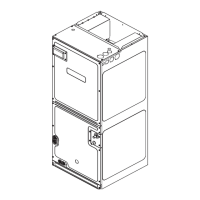7
7 Refrigerant Lines
NOTE: Refrigerant tubing must be routed to allow adequate
access for servicing and maintenance of the unit.
Do not install the air handler in a location that violates
the instructions provided with the condenser. If the unit
is located in an unconditioned area with high ambient
temperature and/or high humidity, the air handler may
be subject to nuisance sweating of the casing. On these
installations, a wrap of 2" fiberglass insulation with a vapor
barrier is recommended.
7.1 Tubing Size
For the correct tubing size, follow the specification
for the condenser/heat pump.
7.2 Tubing Preparation
All cut ends are to be round, burr free, and clean.
Failure to follow this practice increases the chances
for refrigerant leaks. The suction line is spun closed
and requires tubing cutters to remove the closed end.
NOTE: To prevent possible damage to the tubing joints, do not handle coil assembly with manifold or flowrator tubes.
Always use clean gloves when handling coil assemblies.
7.3 Special Instructions
Units without a factory installed TXV come equipped with a flowrator piston for refrigerant expansion. For most
installations with matching applications, no change to the flowrator piston is required. However, in mix-matched
applications, a flowrator piston change may be required. See the piston kit chart (provided in the literature packet)
or consult your local distributor for details regarding mix-matched flowrator piston sizing. If the mix-match appli-
cation requires a different flowrator piston size, change the flowrator piston in the flowrator body on the indoor
coil before installing the coil and use the procedure in section 8.4.
NOTE: The use of a heat shield is strongly recommended when brazing to avoid burning the serial plate or the finish
of the unit. Heat trap or wet rags must be used to protect heat sensitive components such as service valves and TXV
valves sensing bulb.
7.4 Tubing Connections for Flowrator Model
1. Loosen the 13/16 nut 1 TURN ONLY to allow high pressure tracer
gas to escape. No gas indicates a possible leak.
2. After the gas has been expelled, remove the nut and discard the
black or brass cap plastic seal.
3. Remove the flowrator piston to verify it is the correct size for
the outdoor unit being installed and then replace the piston
(changing size, if needed). See piston kit chart in the literature
kit for appropriate piston size.
4. Remove the spin closure on the suction line using a tube cutter
and deburr the tube.
5. Insert the suction line into the connection, slide the insulation and the rubber grommet at least 18" away from the
braze joint.
6. Remove the tailpiece clamped to the exterior of the cabinet or in the literature kit packet and slide the 13/16 nut
into place.
7. Braze tailpiece to the line set liquid tube and braze suction line connection. Quench all brazed joints with a damp
rag upon completion of brazing. Do not allow water to enter the inside of the tubing.
This product is factory-shipped with R410A and dry
nitrogen mixture gas under pressure. Use appropriate
service tools and follow these instructions to prevent
injury.
A quenching cloth is strongly recommended to prevent
scorching or marring of the equipment finish when
brazing close to the painted surfaces. Use brazing
alloy of 5% minimum silver content.
Applying too much heat to any tube can melt the tube. Torch
heat required to braze tubes of various sizes must be
proportional to the size of the tube. Service personnel must
use the appropriate heat level for the size of the tube being
brazed.
CAUTION
RUBBER
GROMMET
SUCTION LINE
WITH SPIN CLOSURE
SUCTION SPUN END AND GROMMET
Figure 10

